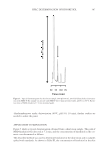J. Cosmet. Sci., 64, 341–353 (September/October 2013) 341 Formulation strategies to modulate the topical delivery of anti-infl ammatory compounds CARMELO PUGLIA, LUISA RIZZA, ALESSIA OFFERTA, FRANCO GASPARRI, VALENTINA GIANNINI, and FRANCESCO BONINA, Department of Drug Sciences, University of Catania, 95125 Catania (C.P., L.R., A.O., F.B.), and R&D, Rottapharm|Madaus, Monza (F.G., V.G.), Italy. Accepted for publication April 1, 2013. Synopsis The aim of this study was to assess the ability of some vehicles (emulsion and emulgel), containing hydroge- nated lecithin as penetration enhancer, in increasing the percutaneous absorption of the two model com- pounds dipotassium glycyrrhizinate (DG) and stearyl glycyrrhetinate (SG). Furthermore SG-loaded solid lipid nanoparticles (SLNs) were prepared and the effect of this vehicle on SG permeation profi le was evaluated as well. Percutaneous absorption has been studied in vitro, using excised human skin membranes (i.e., stratum corneum epidermis or [SCE]), and in vivo, determining their anti-infl ammatory activity. From the results obtained, the use of both penetration enhancers and SLNs resulted in being valid tools to optimize the topical delivery of DG and SG. Soy lecithin guaranteed an increase in the percutaneous absorption of the two actives and a rapid anti-infl ammatory effect in in vivo experiments, whereas SLNs produced an interesting delayed and sustained release of SG. INTRODUCTION During the recent decades, many cosmetic products with biologically active ingredients have been developed and marketed. This category of products showing medicinal or drug-like benefi ts is recognized with the term “cosmeceutical.” Cosmeceuticals are intended to carry out their function as protection, whitening, tan- ning, and antiaging. Like cosmetics, cosmeceuticals are applied topically but differ in that they contain potent ingredients that can infl uence the biological function of the skin and deliver nutrients to promote healthy skin. The extracts of Glycyrrhiza glabra roots contain interesting compounds that are among the most important ingredients used to formulate innovative cosmeceuticals (1). The biological properties of this plant are associated with the presence of glycyrrhizin, a 3-diglucuronide derivative and with its aglycone, glycyrrhetic acid. Some interesting derivatives of these active compounds, such as dipotassium glycyrrhizinate (DG) and Address all correspondence to Carmelo Puglia at capuglia@unict.it
JOURNAL OF COSMETIC SCIENCE 342 stearyl glycyrrhetinate (SG), are used for external use in cosmetic fi eld as lenitive and antireddening agents (2) and in the fi eld of dermatology, because they seem to improve the symptoms of acute and chronic dermatitis (3,4). DG and SG show high chemical stability and emulsifying properties but show different physicochemical features and solubility in fact, while DG has a good water solubility, SG is characterized by a pronounced lipophilic character. These physicochemical properties appear to be unsuitable because actives characterized by extremes of hydrophilic or lipo- philic natures are not well absorbed (5). Different physical and chemical approaches have been developed to overcome the skin barrier and to have better control of active transport across the skin (6–8). Among them, penetration enhancers are one of the most convenient materials and show relatively high effects, interacting with skin constituents to increase the fl ux of active substances (6,9). Another new and very promising strategy is represented by the use of innovative carriers such as solid lipid nanoparticles (SLNs) (10). In recent years, an unmeasured number of research papers have been published describing the use of lipid based carriers for cosmetic application. SLNs with a solid particle matrix are developed from o/w emulsions by sim- ply replacing the liquid lipid (oil) by a solid lipid, i.e., being solid at body temperature (11). Scientifi c literature reports, with different examples, the benefi ts associated to the application of lipid nanoparticle strategy to the formulation of products aimed to dermal administration (12–14). The main advantages recognized for these nanocarriers are the capability to enhance the drug penetration into the skin increasing treatment effi ciency, to target the epidermis, and to reduce the systemic absorption and consequently the side effects of many drugs and cosmetic actives that should limit their activity to the skin lay- ers. However, considering the chemical features of SLNs, these nanoparticles seem to be idoneous to vehiculate lipophilic compounds rather than hydrophilic ones. The objective of this study was to assess the ability of some vehicles (emulsion and emul- gel), containing hydrogenated lecithin as penetration enhancer, in increasing DG and SG percutaneous absorption. Furthermore, SG-loaded SLNs were prepared and the effect of this vehicle on SG permeation profi le was evaluated as well. Percutaneous absorption has been studied in vitro, using excised human skin membranes (i.e., SCE), and in vivo, deter- mining their anti-infl ammatory activity. MATERIALS AND METHODS MATERIALS DG and SG were purchased from Maruzen Pharmaceuticals Co., LTD. (Hiroshima, Japan). Brij® 721P (steareth-21), Brij® 72 (steareth-2), Arlamol® E (PPG-15 Stearyl Ether, butylated hydroxy toluene) were purchased from Croda Italiana S.P.A. (Mortara, Italy). Cetearyl alcohol, Myritol® 318 (caprylic/capric triglyceride), Cetiol® SB45 (Butyrospermum parkii), Pluronic® F68 (poloxamer 188), were purchased from BASF Corporation (Florham Park, NJ). Colonial monolaurin (glyceryl laurate) was purchased by Colonial Chemical, Inc. (South Pittsburg, TN). Dermosoft® OMP (methylpropandiol, caprylyl glycol, phenylpropanol) was purchased from Dr. Straetmans GmbH (Hamburg, Germany). Arginine was obtained by ACEF S.p.A. (Fiorenzuola d’Arda, , Italy). Lecinol® S-10 (hydrogenated lecithin) was obtained by Nikko
Purchased for the exclusive use of nofirst nolast (unknown) From: SCC Media Library & Resource Center (library.scconline.org)





















































































